Week 4 | Eukaryotic Cells & Micoorganisms
1/90
There's no tags or description
Looks like no tags are added yet.
Name | Mastery | Learn | Test | Matching | Spaced |
|---|
No study sessions yet.
91 Terms
true or false: almost all eukaryotic cell contain cell membrane, nucleus, mitochondria, endoplasmic reticulum, golgi apparatus, vacuoles, cytoskeleton, cytoplasm, and glycocalyx but only some have a cell wall, appendages for motility, and chloroplasts
true
what are the primary differences between the eukaryotic flagella and eukaryotic cilia?
the flagella is mainly used for the movement of the cell itself
the cillia is mainly used to move particles along the cell’s surface
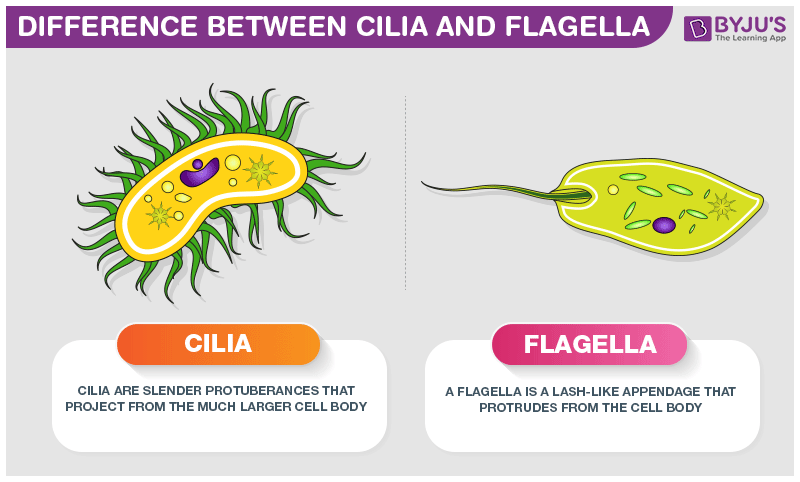
what is the movement of he eukaryotic flagella?
bending motion
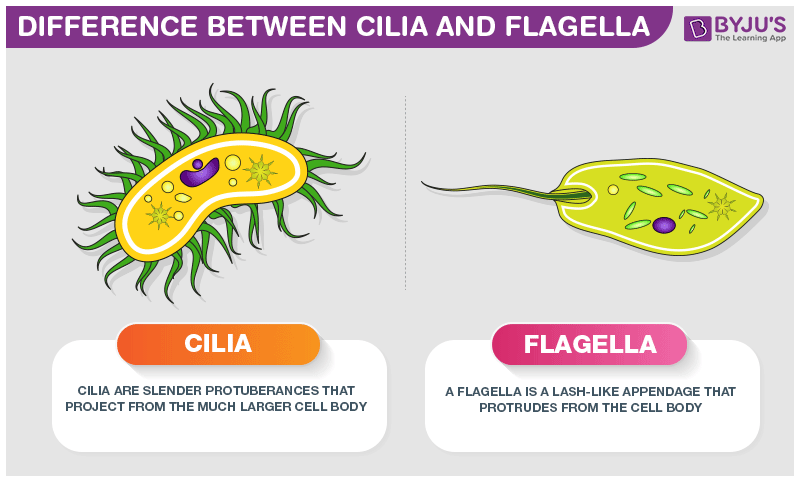
what is the movement of the eukaryotic cillia?
back and forth motion
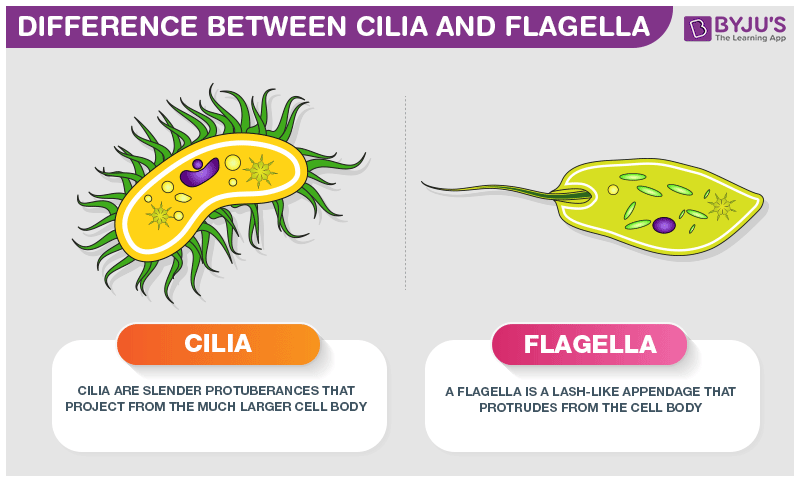
true or false: the glycocalyx of eukaryotic cells are similar to that of the prokaryotes
true
what is the glycocalyx and what is the function of the glycocalyx in eukaryotic cells?
the outermost layer of many eukaryotic cells composed of polysaccharies (not all)
protection of the clel from the chemical and mechanical damage
cell-to-cell recognitions/communication
adhesion to acheor cells together to form tissues
true or false: all prokaryotes and eukaryotes have a cell membrane, but only some have a cell wall
true
what structure in prokaryotes cell wall that eukaryotes with a cell wall does not have?
peptidoglycan
plant cell wall is made of cellulose
fungi cell wall is made of chtin
algae is may be made of cellulose, glycoproteins, or other polysaccharides but never peptidoglycan
Notes: but it does have something similar and that is phospholipi bilayer
what are the eukaryotes with a cell wall?
plants
fungi
algae
some protists
what are the main component of the eukaryotic cell membrane?
phospholipid bilayer
sterols
proteins - embedded or attached, for transport, signaling, and structural support
carbohydrates - usually attached to the proteins (glycoproteins) or lipids (glycolipids) on the extracellular side for cell recognition
the eurkaryotic cell membrane (plasma membrane) is often described as a ___________________
semi-permeable membrane
true or false: while most eukaryotic cell membranes have sterols, most prokaryotic cells do not have sterols (a hallmark of eukaryotes with some prokaryotes exception)
true
what is the biggest organelles in eukaryotic cells?
the nucleus
what are the structures that are stored within the nucleus inside the eukaryotic cells?
nucleolus
chromatin
what separate the nucleus from the cytoplasm?
nuclear envelope
what is the nucleolus in eukaryotic cells?
dense, non-membrane-bound structure within the nucleus of eukaryotic cells that serves as the ribosome factory → synthesize, process, and assemble the ribosomal RNA (rRNA) with proteins to form ribosomal subunits
cytosol vs cytoplasm
cytoplasm refer to everything inside the cell membrane but outside of the nucleus (including both the cytosol and all of the organelles)
cytosol - the fluid, jelly-like subsance that s fills the cells and surround the organelles (make up about 80% of the cell’s volume)
what is the function of the rough endoplasmic reticulum?
Synthesize, fold, modify, and transport protein to the golgi appratus for the final send-off destination
what is the function of the smooth endoplasmic reticulum?
synthesize lipids and steroids (e.g., phospholipids for cell membranes and sex hormones like testosterones)
regulate sodium and ion function
detoxify
what is the glycocalyx that some eukaryotic cells have?
a sugar coating around the cell membrane that protect the cell from physical and chemical damage as well as facilitates cell recognition for immune system and cell adhesion
what is the composition of the nucleus?
composed of two parallel membranes (lipid bilayer) separated by a narrow space
perforated with small, regularly spaced pores → pores allow for transfer of macromolecules into and out of the nucleus
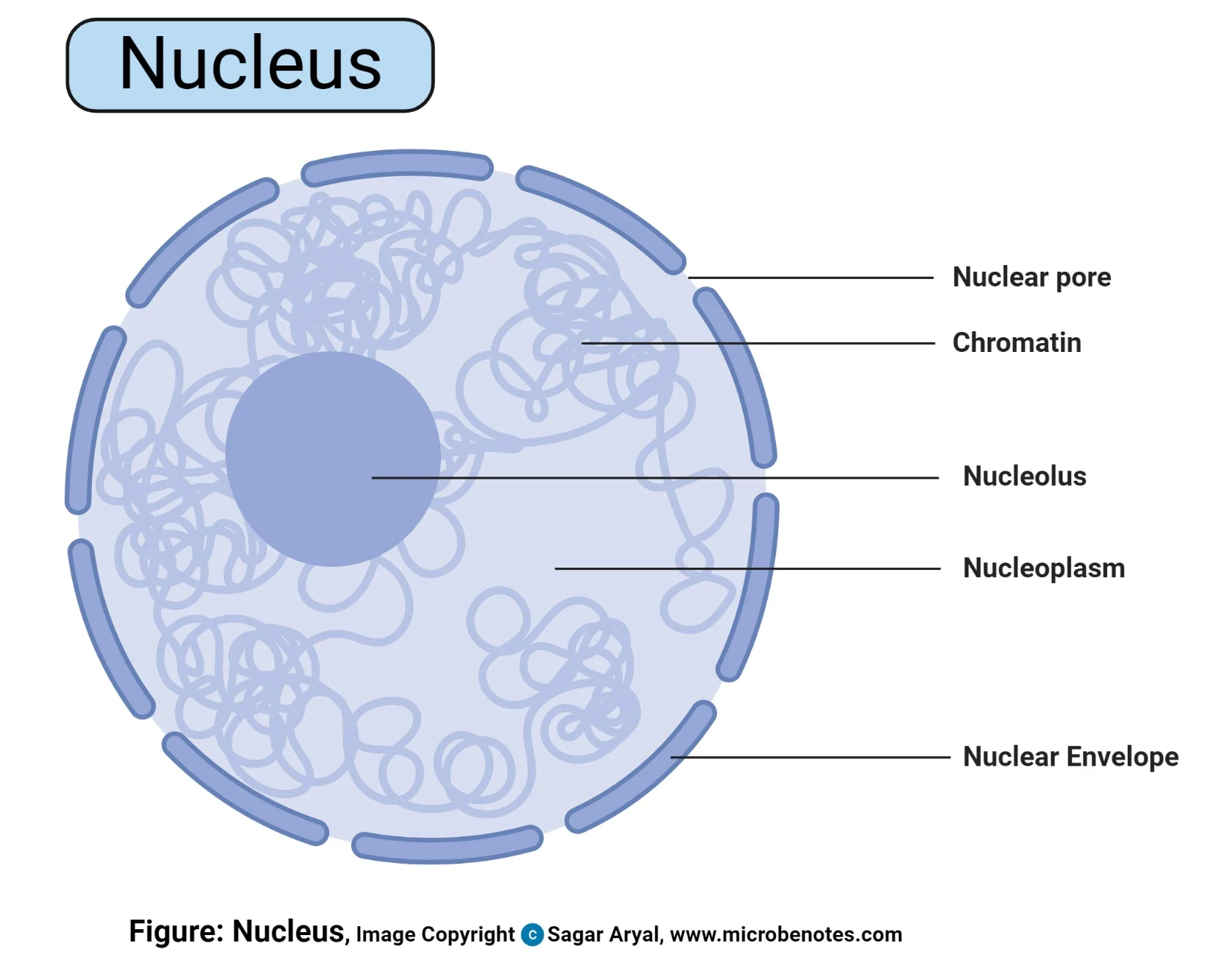
what is the site for ribosomal RNA synthesis and collection area for ribosomal subunits?
the nucleolus!
what is chromatin made up of?
linear DNA and histone proteins
true or false: chromatin is the genetic materials of the cell
true
what is the main structural difference between the rough endoplasmic reticulum and the smooth endoplasmic reticulum?
the rough endoplasmic reticulum look rough because there is ribosomes attaches to outside wall while the smooth endoplasmic reticulum does not contain ribosomes
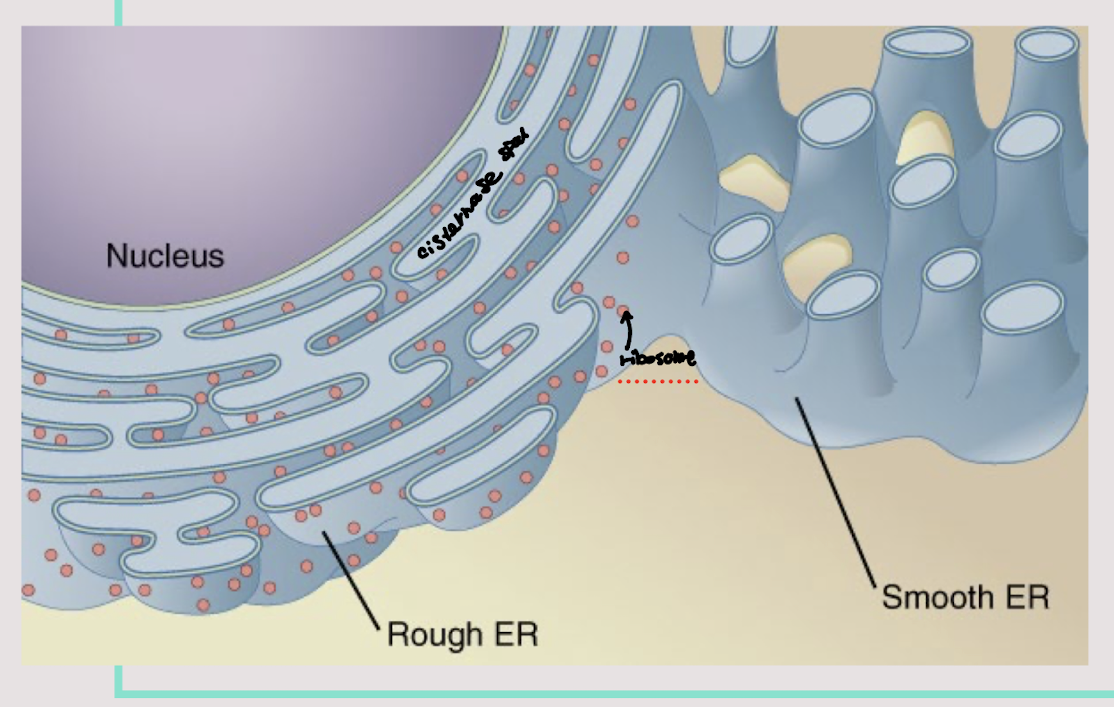
what is the functions of the golgi apparatus?
modify, sort, and package proteins and lipids from the endoplasmic reticulum into vesciles for transport to their correct destinations, whether within or outside of the cell
what are the stakc of flattened disc-shaped sacs of the the golgi apparatus called?
cisternea
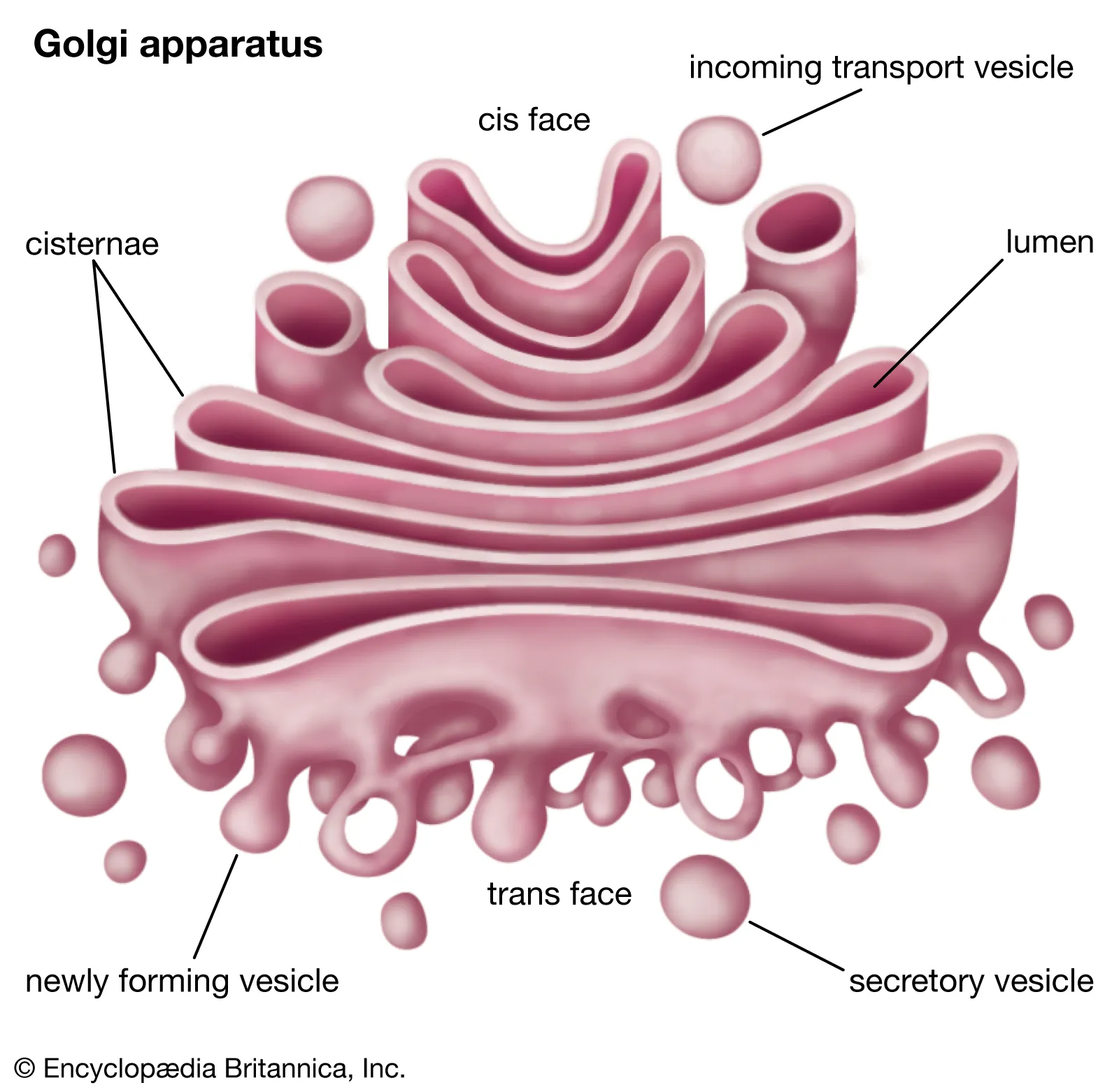
what is the one organelles that is considered to be always closely associated with the endoplasmic reticulum?
the golgi apparatus
is this the right order of the assembly lines of the cell: nucleus → golgi apparatus → endoplasmic reticulum (how do each of these part work?)
NO! nucleus → endoplasmic reticulum → golgi apparatus
a segment of DNA containing the instructions for producing a protein is copied into RNA and this RNA transcript is passed out through the nuclear pores directly to the ribosomes on the endoplasmic reticulum
specific proteins on the RER are deposited in the lumen and transported to the golgi appratus
proteins in the golgi appratus are chemically modified and packages into vesicles to be used by the cell
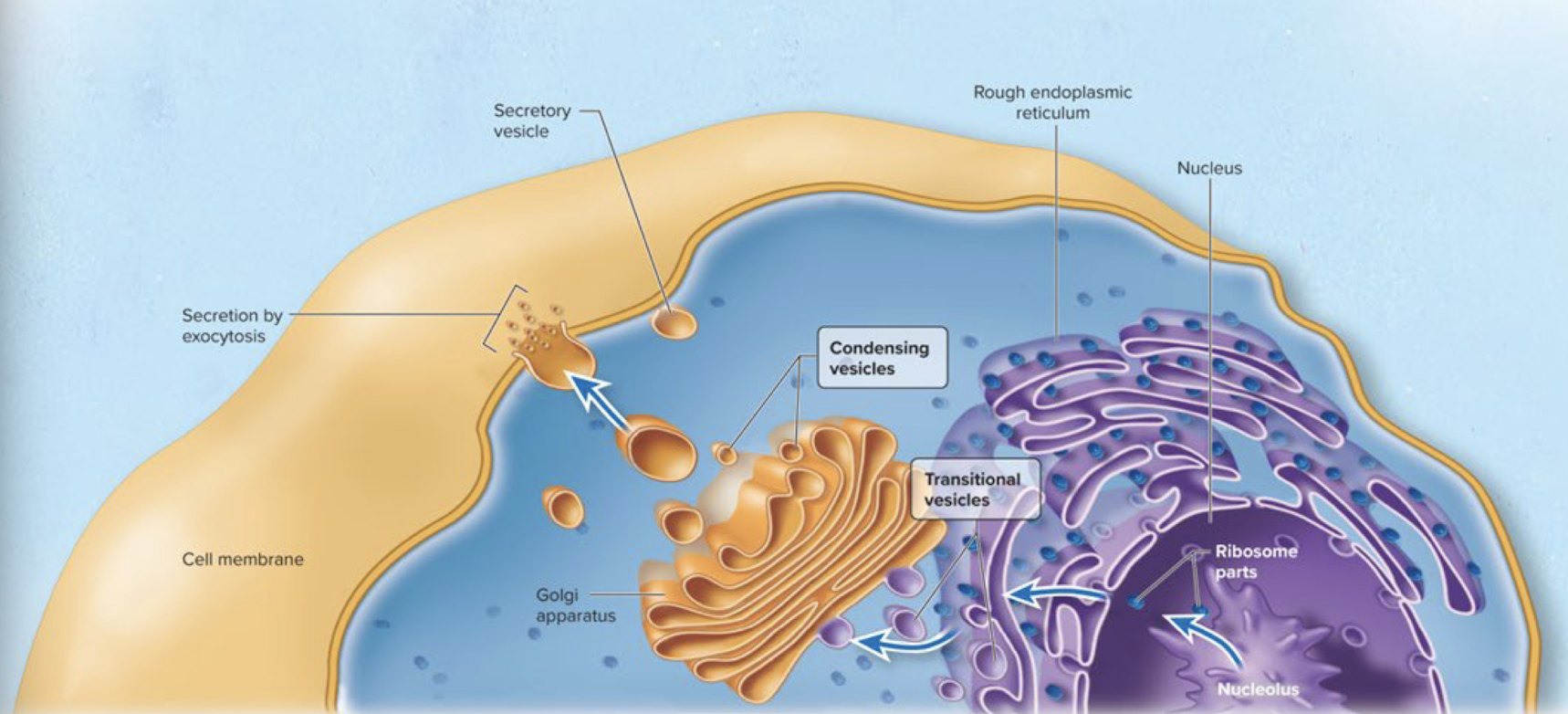
what is the functions of the lysosomes?
contains enzymes that aid in digestion
protects against microorganism
participates in removal of cell debris
what is the function of the vacuoles?
contain materials to be digested, excreted or stores
true or false: phagocytic cells have vacuoles
true! they need to have a vacuoles to store the thing they engulf
what are the steps of eating and digestion for phagocytic cells?
1. Engulfment of Food (Phagocytosis Initiation)
The phagocytic cell detects food particles, microbes, or debris through surface receptors that recognize chemical signals (e.g., bacterial cell wall components, antibodies, or opsonins).
The cell extends parts of its plasma membrane called pseudopodia (arm-like projections) around the particle.
The pseudopodia eventually surround the target completely, enclosing it in a pocket that buds off into the cell’s interior.
2. Formation of Food Vacuoles / Phagosomes
Once the particle is fully engulfed, it is sealed off inside a membrane-bound compartment known as a phagosome (or food vacuole in protozoa).
The phagosome acts as a containment chamber that separates the ingested material from the rest of the cytoplasm.
At this point, the particle is trapped but not yet digested — it’s simply packaged for the next step.
3. Merger of Lysosomes and Vacuoles (Phagolysosome Formation)
Lysosomes, which are small organelles filled with digestive enzymes and reactive chemicals (such as lysozyme, proteases, nucleases, and reactive oxygen species), migrate toward the phagosome.
The membrane of the lysosome fuses with the phagosome to create a phagolysosome.
This fusion brings the particle into direct contact with a highly acidic, enzyme-rich environment optimized for breaking down complex molecules.
4. Digestion
Inside the phagolysosome, enzymes and toxic reactive molecules break down the ingested material into simpler molecules (amino acids, sugars, fatty acids, nucleotides).
The useful products can be absorbed into the cytoplasm for cellular metabolism or building new molecules.
Any indigestible waste remains inside a residual body, which is eventually expelled from the cell by exocytosis.
what are the folds on the inner membrane of the mitochondria called and what are its primary functions?
cristae; hold enzymes and electron carriers for aerobic respiration and extract energy from nutrients and produce ATP
true or false: there is a theory that mitochondria evolved from ancient bacteria
true
where is the sirtes of protein synthesis?
ribosomes
is ribosomes often found in short or long chains?
short
true or false: eukaryotic ribosomes are similar in structure with bacteria’s ribosomes but they are larger in eukaryotic
true
what are the functions of the actin filaments, intermediate filaments, and microtubules?
microtubules - forms the cell’s internal tracks for moving organelles and chromosomes
intermediate filaments - provide structural strength and stability
actin filaments - support cell shape and enable movement and contraction
which of the following characteristics is evidence that mitochondria evolved from bacterial cells?
circular chromosomes
bacteria-like ribosomes
capable of independent division
all of the choices above are correct
all of the choices are correct
which of the following organelles is repsonsible for protein modification and distribution in the cell?
nucleus
golgi apparatus
endoplasmic reticulum
mitochondrion
ribosomes
endoplasmic reticulum
what are the general shape of yeasts?
round to oval shape
how does yeast reproduce?
asexually through budding
what does the hyphae look like?
long, threadlike cells found in the bodies of filamentous fungi
pseudohyphae are chains of _________ cells
yeasts
what does it mean for fungal cells to be dimorphic depending on growth conditions?
this mean that fungi can switch in between either:
yeast form - single-celled, round shape usually in warm environment, like inside of the body
mold form - multi-cellular, filamentous hyphae usually in cooler environments like in the soil
true or false: the three types of fungal diseasse are community-acquired, hospital-acquired, and opportunistic
true
the term for a fungal infection is a _________________
mycosis
what is a candida infection?
a specific type of fungal infection caused by Candida
A patient diagnosed with a fungal infection is prescribed the antifungal voriconazole for treatment. The nurse is familiar with the action of this medication and educates the patient that it impairs ergosterol synthesis. Which one of the following cellular structures is most likely to be affected by voriconazole?
a. Cell membrane
b. Nucleus
c. Ribosomes
d. Mitochondria
cell membrane
what are the “good” functions of fungi?
decompose organic matter
improve plant’s ability to absorb water and nutrients
used in production of antibiotics, alcohol, and vitamins
some can be eaten or used to flavor foods
what are the “bad” functions of fungi?
can trigger allergies
cause infection
destroy crops
rot fresh produce
what kind of troph (general & specific type) of fungi and what arre their food source?
they are heterotroph (can’t make their down food and must get nutrients from other organisms)
they are specific saprobes - a tpe of heterotroph that feeds on dead or decaying organic matter → can digest an incredible variety of materials
true or false: fungi most grow in loosely associated colonies
true
the woven, intertwining mass of hyphae that make up the body or colony of a mold is called the ____________
mycellium
what is the septae found in the hyphae of most fungi?
cross-walls that divide the hyphae (the long, thread-like filaments of fungi) into individual cells → some like nonseptate hyphae consist of one, long, continuous cells
what are the functional category of hyphae and what are their specific characteristics?
vegetative hyphae - produce visible mass of growth that appears on a substrate
reproductive (AKA fertile) hyphae produce spores
what is the primary mode of reproduction for fungi?
spore
true or false: fungi can be dispared through the environmen by air, water, and living things
true
what type of organisms will germinate upon finding a favorable substrate and produce a new fungus colony in a short time
fungi
from which sources can fungi derive nutrients?
dead plants and animals
living tissues
rubber petroleum
All of the choices above are correct
all of the choices above are correct
what is the single cell organism that contain all of the major eukaryotic organelles
protozoa
which organism have cytoplasm that is divided into two parts? (provide a brief description of these two compartment)
ectoplasm - clear outer layer involved in locomotion, feeding, and protection (firm, stretchy balloon skin)
endoplasm - granular inner region housing the nucleus, mitochondria, and food and contractile vacuoles (gooey water inside)
how do protozoans obtain food?
some have special feeding structures like oral grooves
some absorb nutrients directly through the cell membrane
they may live on host fluids such as plasma or digestive juices or actively feed on host tissues
where are protozoans commonly found?
freshwater
marine water
soil
plants
animals
can protozoans survive in extreme environment?
yes, protozoans can survive extreme temperatures and pH levels
what is the motile, feeding stage of protozoa called?
the trophozoite; the active feeding stage that requires food and moisture to survive
what are the conditions needed for a trophozoite to stay active?
ample food and moisture are required for the trophozoite stage to remain active
what is the cyst stage for protozoa?
a dormant, resting stage that forms when environmental conditions become unfavorable
what are the cysts of protozoan resistant to?
resistant to heat, drying, and chemicals
how can protozoan cysts spread disease?
can be dispersed by air currents, allowing them to spread and infect new hosts
what are the stages of the protozoan life cycle, in order?
trophozoite - active, motile feeding stage; requires food and moisture to survive
early cyst formation - when conditions become unfavorable (drying, lack of nutrients), the cell rounds up and loses motility
mature cyst - dormant, resting stagel resistant to heat, drying, and chemical → can survive harsh environment
cyst wall breaks open - when moisture and nutrient return, the cyst opens
trophozoite reactivation - the trophozoites becomes active again and resumes feeding
The active, feeding, and motile stage of the protozoan life cycle is the ___________ stage.
a. cyst
b. endospore
c. trophozoite
d. merozoite
e. all of the choices are correct
c. trophozoite
true or false: not all flatworm and roundworms are parasites
true!
what is another name for flatworms and what is their body structure like?
phylum Platyhelminthes
they hav a very thin, often segmented body
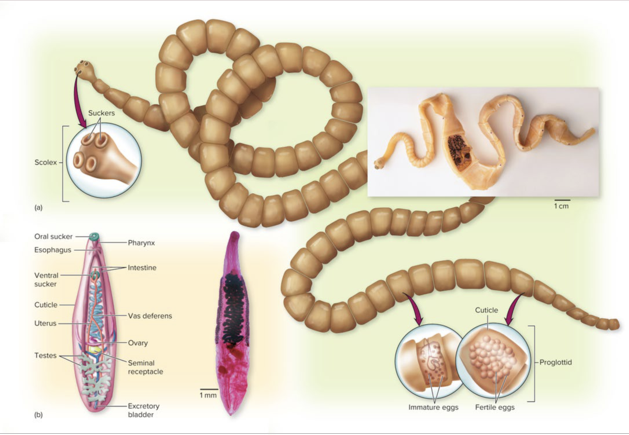
what are the two main types of flatworms?
cestodes → tapeworm
trematodes → flukes
what is another name for roundworms and what is their body structure like?
roundworms belong to phylum Aschelminthes (Nematoda); their body is elongated, cylindrical, and unsegmented
what is the most developed organ in pathogenic helminths? and which one are more rudimentary?
reproductive tract; digestive, excretory, nervous, and muscular systems are more rudimentary
what are the three main stages in the complete life cycle of helminths?
fertilized egg
larval stage
adult stage
what do adult helminths do inside their host’s body?
they derive nutrients and reproduce sexually in the host
how do nematodes (roundworms) reproduce?
sexual reproduction between male and females - nematodes are not hermaphrodites and have distinct male and female organism
how do trematodes (flukes) reproduce?
sexual reproduction can be separated between male and female or it happens with hermaphroditic flukes (having both male and female organs)
how do cestodes (tapeworms) reproduce?
they are generally hermaphroditic
how do helminths (parasitic worms) spread to new hosts?
they must transmit an infective form (either an egg or larva) into the body of another host
what are the two types of host in a helminth life cycles?
Definitive (primary) host – this is where the helminth reaches sexual maturity and reproduces.
Intermediate (secondary) host – this is where the helminth develops through larval stages, but does not become an adult.
what is the process of the helminth moving from the intermediate to the definitive host?
Eggs or larvae are released from the definitive host into the environment (like water, soil, or another animal).
These larvae infect the intermediate host, where they develop further (but don’t become adults).
Then, the parasite moves to the definitive host—often when the definitive host eats the intermediate host or comes into contact with contaminated water or soil.
In the definitive host, the parasite matures into an adult and can reproduce, completing the cycle.
what is a transport host?
it is an intermediate carrier that harbors the parasite but no development occurs inside it
what are the common sources of human infections by helminths?
contaminated food, soil, and water, or infected animals
what special features do helminth eggs have to help larval development?
they are provided with a protective shell and extra food
give an example of a helminth that lays eggs
pinworms (Enterobius vermicularis)
adulthood and mating of helminths occurs in the __________
a. larvae
b. intermediate host
c. cyst
d. definitive host
e. egg
definitive host